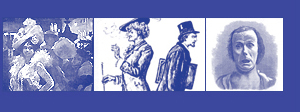Sexuality
Author : (1813 -)
Title : Prostitution Considered in its Social and Sanitary Aspects
Keywords: Prostitution, immorality, disease, sin, health, lower classes, labour, female labour, female education, Contagious Diseases Act, contagion, speculum, examination
| Pages : | Intro |
Introduction
William Acton was born in 1813 in Dorsetshire, the second son of a clergyman. From 1831 – 1836 he was employed as apprentice to the Resident Apothecary to St. Bartholomew’s Hospital London. It appears that his professional interest in sexuality dates from his move to Paris in 1836. While there, Acton studied diseases of the urinary and generative organs under the well-known American genito-urinary surgeon Phillippe Ricord, and also spent some time working at the Female Venereal Hospital. On his return to England in 1840 Acton began practising gynaecology, and the same year was admitted as a Member to the Royal College of Surgeons. Two years later he also became a Fellow of the Royal Medical and Chirurgical Society of London. In 1841 he published his first book, A Practical Treatise on Diseases of the Urinary and Generative Organs in Both Sexes. The book proved a success, running through four editions by 1875. However, it was Acton’s second book which has proved of most interest to historians of sexuality. This book was also a success: a second edition was published in 1858, a French translation in 1863, and by 1894 the English version was on its eight edition. The Functions and Disorders of the Reproductive Organs, in Childhood, Youth, Adult Age, and Advanced Life, Considered in the Physiological, Social, and Moral Relations (1857) was an attempt to comprehensively study male sexuality, including the subject of masturbation.
However, subsequent commentators have been more concerned with Acton’s views on female sexuality. It is in this work that Acton’s most famous statement, ‘I should say that the majority of women (happily for them) [‘them’ was changed to ‘society’ in later editions, for reasons which are not clear] are not very much troubled with sexual feeling of any kind’. Acton’s views on female sexuality are actually far more complex, as can be seen in his third work, Prostitution, Considered in its Moral, Social, and Sanitary Aspect, in London and other large cities and Garrison Towns, with Proposals for the Control and Prevention of Attendant Evils (1858). After the Contagious Diseases Acts (1866) were passed, an enlarged and expanded edition of Prostitution was published (1870). Acton’s consideration of the problem of prostitution was in many respects balanced and liberal. He argued that prostitution is an inevitable part of society which cannot be entirely wiped out, therefore it should be regulated as the greatest danger lies in ignoring the problem. Although he has been criticised by modern writers for addressing the supply rather than demand side of the equation (concentrating on regulating the prostitute rather than tackling the wider problem of male sexual attitudes), his views on the prostitute herself were largely atypical. Against popular opinion, he wrote about the prostitute as a fellow human being rather than a disgraced and alien ‘other’, stating that most women entered the trade because of poverty. He also corrected the view that prostitutes inevitably die young and diseased, arguing that most prostitutes enjoyed better health than working women who had to attend to ‘the cares of a family and the heart-wearing struggles of virtuous labour’. Only recent has Acton’s problematic status as a source of information on Victorian sexuality become apparent. Steven Marcus’ The Other Victorians (1964) claimed that Acton was representative of medical attitudes, but subsequent commentators (Weeks, Sex, Politics and Society; Porter and Hall, The Facts of Life) have both drawn out the ways in which Acton was atypical, and attempted to contextualise his work to a greater extent, arguing for example that Acton’s comments on female sexuality in Functions and Disorders should be seen as aimed at reassuring a young, middle-class, male readership.
Major works:
A Practical Treatise on Diseases of the Urinary and Generative Organs in Both Sexes (1841)
The Functions and Disorders of the Reproductive Organs, in Childhood, Youth, Adult Age, and Advanced Life, Considered in the Physiological, Social, and Moral Relations (1857)
Prostitution, Considered in its Moral, Social, and Sanitary Aspect, in London and other large cities and Garrison Towns, with Proposals for the Control and Prevention of Attendant Evils (1858; second enlarged edition 1870)
Secondary sources
S. Marcus, The Other Victorians (1964)
| Pages : | Intro |

